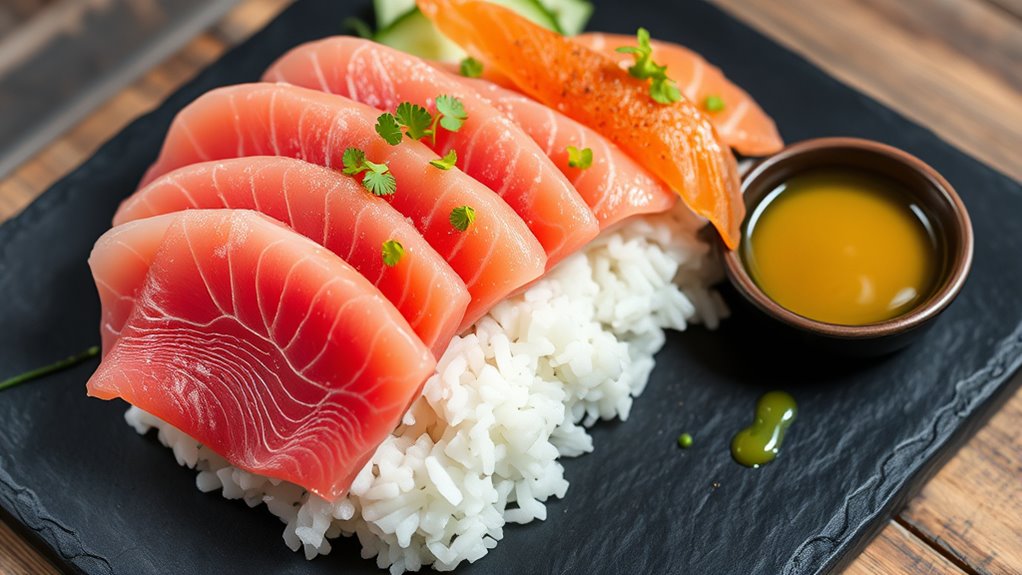To enjoy flavorful sushi with less sodium, try using fermented condiments like miso or tamari, which provide rich umami without high salt levels. Incorporate natural ingredients such as seaweed, kelp, or citrus to boost flavor naturally. Small amounts of these alternatives can enhance your sushi’s taste while keeping it health-friendly. Balancing flavors with natural acids and seasonings helps maintain the authentic profile—keep exploring to discover more tasty, low-sodium options.
Key Takeaways
- Fermented condiments like tamari and miso provide rich umami flavor with less sodium compared to traditional soy sauce.
- Incorporating seaweed-based ingredients such as nori or kelp powder adds natural saltiness and umami without high sodium content.
- Blending natural acids like rice vinegar or lemon juice with fermented condiments enhances flavor while reducing salt reliance.
- Using small amounts of fermented products and natural seasonings balances flavor without overpowering delicate sushi ingredients.
- Emphasizing fresh ingredients and flavor techniques helps achieve satisfying sushi taste while minimizing sodium intake.

If you’re looking to enjoy raw sushi without consuming excess sodium, there are plenty of low-sodium alternatives that can help you savor this delicacy healthily. Traditional soy sauce, while flavorful, is high in sodium, prompting many to seek smarter options. One effective approach involves exploring fermentation techniques that produce naturally salty condiments with reduced salt content. For example, fermented vegetables like miso or tamari, which are made through natural fermentation, offer rich umami flavors that can mimic the salty punch of soy sauce but with less sodium. These alternatives not only provide depth to your sushi but also introduce beneficial probiotics, enhancing your digestive health.
Explore low-sodium fermented condiments like miso and tamari for flavorful sushi alternatives.
To achieve the ideal flavor balancing, it’s crucial to understand how to incorporate these low-sodium options without overpowering the delicate taste of the fish and rice. Using small amounts of fermented products allows the umami to enhance your sushi, rather than dominate it. You might also experiment with blending fermented condiments with other seasonings like rice vinegar, lemon juice, or a touch of honey to create a custom dipping sauce. This approach helps regulate saltiness while maintaining a harmonious flavor profile, ensuring each bite is satisfying without excess sodium.
In addition to fermented condiments, consider using natural ingredients that bring savory flavors without added salt. For instance, seaweed-based products like nori or kelp powder lend a subtle briny taste that complements raw fish beautifully. These ingredients are rich in natural umami, which can help reduce your reliance on salty sauces altogether. Another option is to prepare a dipping sauce with fresh citrus, ginger, or wasabi, which adds piquancy and complexity without the need for high-sodium ingredients. These natural flavors invigorate your palate and emphasize the freshness of the raw fish.
Ultimately, the key to enjoying raw sushi with low-sodium alternatives lies in your ability to balance flavors thoughtfully. By leveraging fermentation techniques and selecting ingredients that naturally enhance umami, you create a more health-conscious yet flavorful experience. Small adjustments—like using fermented soy alternatives, adding aromatic acids, or incorporating seaweed—allow you to savor sushi without compromising taste. With a bit of experimentation and an understanding of flavor balancing, you can enjoy this beloved cuisine in a way that aligns with your health goals, all while preserving the authentic essence of raw sushi.
Frequently Asked Questions
Are Low-Sodium Options Suitable for All Types of Sushi?
You might wonder if low-sodium options suit all sushi types. While ingredient substitutions like low-sodium soy sauce can work well, flavor adaptation varies. For delicate fish or subtle flavors, these alternatives often enhance the experience without overpowering. However, for stronger-tasting ingredients, you may need additional seasonings. Ultimately, testing different low-sodium options helps you find the best balance, ensuring your sushi remains flavorful and satisfying.
How Do Low-Sodium Alternatives Impact Traditional Sushi Flavor?
Like a gentle breeze shifting the tide, low-sodium alternatives subtly change your sushi’s flavor profile. You might notice a slight reduction in umami perception, making the flavor balance feel lighter. While they preserve the essence, some depth may be missing, so you’ll want to choose options carefully. Ultimately, they help you enjoy sushi with less salt without sacrificing too much of that beloved traditional taste.
Can I Prepare Low-Sodium Soy Sauce at Home?
You can definitely prepare low-sodium soy sauce at home using homemade recipes. Start by mixing brewed tea or mushroom broth with soy or coconut aminos to create a savory base. Adjust the flavor with a pinch of salt, if needed, but keep it light. This way, you control the salt content and make flavor adjustments to suit your taste, resulting in a healthier, customized sauce perfect for sushi.
Do Low-Sodium Condiments Affect Sushi Dipping Techniques?
Ever wondered if low-sodium condiments change how you dip sushi? They do, but it’s not a problem. You can try alternative dipping methods, like lightly brushing the fish with flavored oils or using wasabi and pickled ginger for flavor enhancement techniques. These options let you enjoy sushi without sacrificing taste. Adjust your technique accordingly, and you’ll find that low-sodium alternatives can still deliver a delicious, well-balanced flavor.
Are There Any Health Benefits to Choosing Low-Sodium Sushi Accompaniments?
When you choose low-sodium sushi accompaniments, you’re making a smart move for your health. Sodium reduction helps lower your risk of high blood pressure and cardiovascular issues. The health benefits include better heart health and reduced water retention. By opting for these alternatives, you enjoy sushi without compromising flavor while supporting your overall well-being. It’s a simple yet effective way to indulge mindfully and prioritize your health.
Conclusion
As you explore these low-sodium alternatives, think of your palate as a delicate orchestra, where each note matters. By choosing gentler flavors, you craft a symphony that’s both vibrant and mindful. Let your sushi experience be like a gentle breeze—a subtle whisper of flavor that leaves a lasting impression without overwhelming. Embrace these mindful choices, turning every bite into a harmonious dance of taste and health, where balance reigns supreme.










